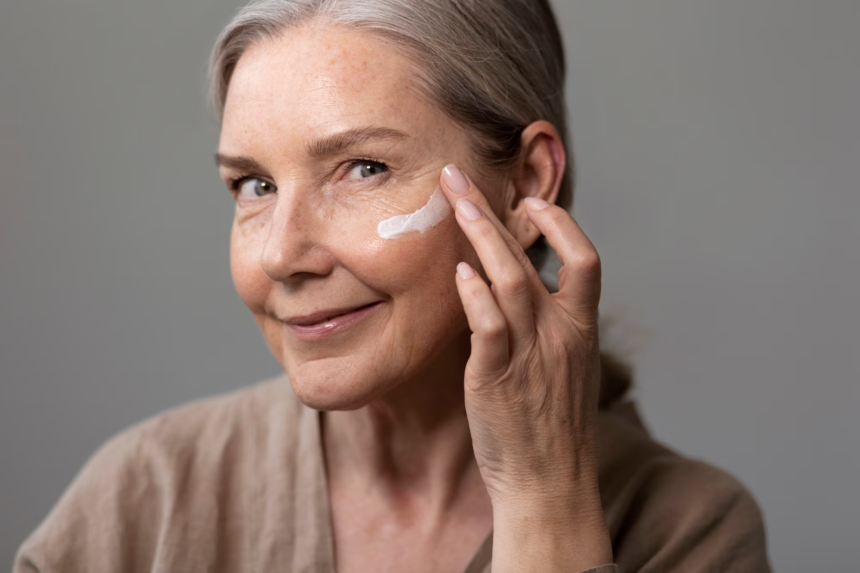While beauty brands fixate on Millennials and Gen Z, they’re overlooking a powerhouse consumer: Baby Boomers. In the U.S. alone, Boomers spend nearly $180 billion annually on beauty products, with 47% regularly purchasing skincare. Globally, they’re driving a “silver economy” projected to hit $15 trillion by decade’s end. Unlike younger shoppers, they’re fiercely brand-loyal and eager to invest in products that enhance well-being, support active lifestyles, and maintain their vibrant appearance. Holding more than 50% of disposable income in developed markets, Boomers aren’t passively aging out of beauty—they’re living longer, working later, and spending more. Their influence on the industry is undeniable, yet often overlooked.
What are Boomers looking for in beauty products? Simplicity, multifunctionality, and efficacy
Simplicity and multifunctionality: Boomers don’t have time for your 10-step skincare routine: Boomers aren’t interested in layering essence, serum, ampoule, and mist like a 25-year-old skincare enthusiast on TikTok. Convenience is key. According to Mintel, 40% of Baby Boomers want to simplify their beauty routines, while 63% actively seek multifunctional products. This is where hybrid formulas shine: moisturizers that hydrate, firm, and protect with SPF in one step, or serums that brighten while tackling fine lines. The appeal is clear: less time, more impact.
Targeted solutions with proven efficacy: Skip the hype, show the results
Boomers don’t buy into vague promises—they buy into results. Their concerns aren’t abstract; they’re visible, tangible, and deeply personal. Loss of skin elasticity, hyperpigmentation, and prolonged sun exposure can’t be solved by a one-size-fits-all “anti-aging” label. News flash: everyone ages. The real question is how brands choose to address it.
The opportunity lies in precision. Evidence-backed formulations that directly target brown spots, thinning skin, or sun-induced sensitivities are building dedicated followings. Oncology-focused skincare is gaining traction for its ability to combat long-term UV damage. Brands that move beyond broad, age-coded messaging and embrace science-driven, results-oriented solutions will gain not just trust but long-term loyalty.
Hair Care remains a major concern: More than just covering grays
For Boomers, hair is identity. Thinning strands, changing texture, and graying hair aren’t just cosmetic concerns—they’re deeply personal. Yet the industry’s default response has been hair dye, overlooking a growing demand for solutions that strengthen, restore, and enhance aging hair.
Virtue Haircare leads this charge, dominating searches for “menopausal haircare” by addressing real, unmet needs. Their choice of Jennifer Garner as brand face is strategic: she’s old enough to be credible, yet youthful enough to represent aspirational vitality. And yet, despite this savvy positioning, their website noticeably lacks representation of the full age range they could be capturing. Brands that recognize the power of showing their consumer, not just selling to them, will be the ones that truly resonate.


In a market full of promises, transparency matters more than ever
Boomers don’t buy into beauty myths—they buy facts. They’re label-readers, ingredient researchers, and comparison shoppers. In an era where wellness and longevity are paramount, they scrutinize what goes on their skin as carefully as what goes into their bodies.
For brands, vague claims and buzzwords fall flat. Clear, science-backed communication isn’t optional—it’s essential. The winners in this space will be those that prioritize transparency, efficacy, and ingredient integrity, proving their products work rather than just claiming they do.
Affordable luxury: Boomers will pay for quality, but on their terms
Boomers may hold the majority of disposable income, but they don’t spend carelessly. They’re discerning, value-driven consumers who expect performance to justify price. The real opportunity lies in masstige—products that merge mass-market accessibility with prestige-level efficacy.
According to a McKinsey report, 65% of Boomers will pay more for products offering both luxury and practicality. Brands like L’Oréal and Olay have mastered this balance, delivering science-backed formulations without ultra-luxury prices. But pragmatism doesn’t mean reluctance—when a product delivers tangible results and a sense of indulgence, Boomers readily invest. The challenge for brands? Ensuring premium pricing aligns with proven efficacy. In a market full of claims, only those who deliver will earn lasting loyalty.
Marketing beauty to Baby Boomers: Authenticity, reliability, and proof—no gimmicks, just trust
Real people, real influence: Why representation matters: Seventy percent of Boomers are more likely to trust an influencer their own age, and that trust translates into sales. They connect with people who understand their reality—women in their 50s and 60s who speak candidly about menopause, skin texture changes, and proven solutions. This explains the evolving influencer landscape. Brands seeking success should embrace voices with lived experience rather than aspirational aesthetics.


Relatability and aspiration make age-appropriate beauty influencers the most effective choice. Proof over promises: No one’s buying “reversing 20 years”: Overpromising destroys credibility. The smartest brands know that clinical trials, authentic before-and-after images (without excessive retouching), and ingredient transparency aren’t just nice-to-have—they’re essential to conversion.
Meet them where they are: Facebook, YouTube, and TV still matter: Despite lingering stereotypes, Baby Boomers are highly engaged online—just differently than younger consumers.
Facebook (75%) and YouTube (57%) dominate their digital habits. These platforms aren’t just for connecting with friends—they’re spaces for watching product reviews, following trusted influencers, and engaging with favorite brands.
TV Still Drives Awareness: Boomers make up 55% of the TV audience, making them the largest viewer segment. But there’s a shift: TV is no longer the endpoint—it’s the opening act, with social media driving deeper engagement.
A successful strategy isn’t either-or—it’s multi-channel.
Nostalgia Works—But Only When It’s Authentic: Nostalgia can be powerful, but forced nostalgia backfires. Boomers don’t want gratuitous reminders of the past—they want their experiences respected. A masterclass in getting this right? Estée Lauder’s reintroduction of Paulina Porizkova as a Global Ambassador after 30 years. Rather than chasing youth, the campaign celebrated aging with confidence—a message that resonated deeply. Done well, nostalgia builds trust. Done poorly, it feels like pandering.


The Bottom Line: Trust is the ultimate currency
Baby Boomers don’t impulse-buy—they invest in brands that prove their worth. They demand honesty, efficacy, and marketing that respects their intelligence. The formula for success is straightforward: Relatable voices, tangible results, and a platform strategy that meets them where they are. Brands that master this won’t just win sales—they’ll earn lasting loyalty that spans generations.



